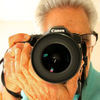After selecting Program mode (P), what should you do next?
Dec 18, 2017 10:37:34 #
ronf78155
Loc: Seguin Texas
Go to Amazon and buy the book Canon 77d for Dummies or Photography for Dummies.
Very good learning tools that use the KISS method of instruction
Very good learning tools that use the KISS method of instruction
Dec 18, 2017 10:38:47 #
Don W-37
Loc: Bangkok, Thailand
Most of the folks are hard core and they are correct. But these days, cameras give good results in P & ISO Auto, if you are just taking snapshots. Note that you can use exposure compensation in P but not in A. On Nikon, you have to deploy the flash yourself in P, but the camera decides in A. Good luck & happy shooting.
Dec 18, 2017 10:43:25 #
Don W-37 wrote:
Which A are you talking about. "A" on my Nikons stands for Aperture Priority and exposure compensation works fine. If you are talking about "AUTO" that could be a different story. Most of the folks are hard core and they are correct. But these days, cameras give good results in P & ISO Auto, if you are just taking snapshots. Note that you can use exposure compensation in P but not in A. On Nikon, you have to deploy the flash yourself in P, but the camera decides in A. Good luck & happy shooting.
--
Dec 18, 2017 10:47:07 #
"P" allows me to set the focus zone to center point. "AUTO" selects a number of focus points, usually all wrong. I have been doing this long enough to know what ranges, not specific exact values, will give me a good photo. I check all the information in the viewfinder and if the camera's settings are withing these ranges I can go back to composition, focus and timing.
Dec 18, 2017 10:49:28 #
So glad you finally have a DSLR headed your way. Please do yourself a favor and forget all the other modes your camera can shoot in, for the time being, and learn only the manual setting. I believe I posted this to you before but here it is again: go to www.udemy.com and look up a video named "Photography: Ditch Auto-Start Shooting in Manual. This is a FREE comprehensive course and will teach you ALL you need to know. It is structured for the beginner so you will understand. After you become familiar with manual then you will have a big head start on using the other modes. All the hogs mean well but I'm concerned you may become so confused with all the different advice about what this will do and do this first, etc I am afraid you will become discouraged. Settle yourself in with this course, learn it, practice what it teaches and your confidence will soar. We all want you to become the best photographer you can but unless you learn to shoot in manual first you might as well have stuck with point and shoot cameras or bridge cameras. Whether you take my advice or not I wish you nothing but the best. Merry Christmas to you and yours.
Dec 18, 2017 10:55:19 #
CanonTom
Loc: Birmingham
Bill_de wrote:
Where am I wrong? br br With flexible program, Ni... (show quote)
This leaves ISO totally out of the picture which if the camera sets it you could get lots of noise if its too high, if you already set it nice and low, you could easily end up with exposure so dark or so light the picture could be useless.
Dec 18, 2017 11:19:48 #
Don W-37
Loc: Bangkok, Thailand
In my prior post I said A but meant Green A (full automatic). That was confusing. Sorry about that!! Dumb mistake. Cheers, Don
Dec 18, 2017 11:49:39 #
GalaxyCat wrote:
Okay, learn manual first, then Aperture Priority, ... (show quote)
Read the manual as you learn how to use the camera. In the "P" mode, the shutter and aperture are set automatically, but you can change the shutter speed and aperture combination and still have
the same exposure by turning the main dial until desired shutter and aperture are displayed. Once you see how that affects your exposures, you can go to "TV"(shutter priority) for action or movements
shots or "AV"(aperture priority) for portraits, still live, landscapes. Gives you more or less depth of field. I feel when you are familiar with how your camera works, then go to "M"(manual). This, of
cause, gives you greater control of your exposures as you set both the shutter speed and aperture you want. Don't use the "A" or green zone. It is strictly AUTO. Using that is a waste as you might
as well use a point and shoot camera.Good luck to you. By the by, I bought the Canon EOS 620 when it first came out in 1987.
I still have and use it every so often. Still works perfectly. One other thing. Keep on shooting...
Dec 18, 2017 12:12:23 #
billnikon wrote:
You appear to be conceding the control of the camera to the camera. In that case I strongly suggest setting the ISO to auto. Now you can shoot without having to think. And since you appear to be blonde, this may be your best option.
NO NO NO. ISO stays under my control. I'm turning over to the camera, under my supervision, the things it can do well, while I concentrate on the things {like composition} that it cannot do well. With my next camera I may give it control over ISO with a limited range, because modern cameras {apparently, based on DxoMark scores, this is less true of Nikon than of others} are doing so much better within certain ranges.
Dec 18, 2017 12:26:45 #
bpulv
Loc: Buena Park, CA
GalaxyCat wrote:
If you select P, what is the next step? Adjust ISO?
The straight answer to your question is to choose which program you want to use. You did not specify which camera you are using, but if you are using a point and shoot camera you may find different modes such as portrait, landscape, neutral, vivid, etc. on the rotatable control shown with symbols, usually on the top of the camera. If you are using a DSLR, such as Nikon, you will find the builtin programs in the Shooting Menu under Set Picture Control.
I suggest however, that you read your camera's manual and become familiar with all the modes so you can pick the appropriate mode for what you are photographing. You should wean yourself from the P-mode as soon as possible because you will screw up more pictures than you can imagine in program mode. You should also read some articles on the internet or buy a book and learn the relationship between the three things that control your picture; ISO (sensor sensitivity to light), shutter speed and f-stop (lens opening). In order to fully control your results, your goal should be to learn to be able to take a light measurement and set your camera manually rather than depend on your camera's computer.
Dec 18, 2017 12:54:28 #
wdross
Loc: Castle Rock, Colorado
GalaxyCat wrote:
If you select P, what is the next step? Adjust ISO?
Set up the dials for the functions you want to be able to change. For me it is exposure compensation and aperture. This means that the ISO and shutter change to the cameras programing.
Dec 18, 2017 13:14:56 #
"You did not specify which camera you are using". Actually, she did - Canon 77d. I guess you missed that in her original post?
Mark
Mark
bpulv wrote:
The straight answer to your question is to choose ... (show quote)
Dec 18, 2017 14:21:23 #
Humor like this was seen as funny by some at one time but has no place in todays world. It doesn't make you laugh, it just makes you cringe.
billnikon wrote:
You appear to be conceding the control of the camera to the camera. In that case I strongly suggest setting the ISO to auto. Now you can shoot without having to think. And since you appear to be blonde, this may be your best option.
Dec 18, 2017 14:29:32 #
Assuming you are fairly new to this sport, aim and fire. You will learn all the more choice shooting modes as you progress and experiment.
Dec 18, 2017 14:31:24 #
I think in this discussion some people are saying A when they mean Auto. A is aperture priority. Auto is Auto. Mixing them up makes some of the comments here not make sense.
GalaxyCat wrote:
If you select P, what is the next step? Adjust ISO?
If you want to reply, then register here. Registration is free and your account is created instantly, so you can post right away.






